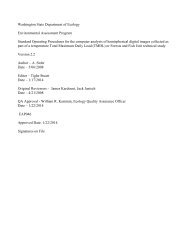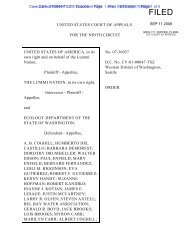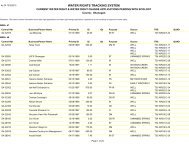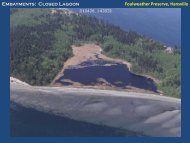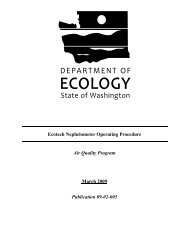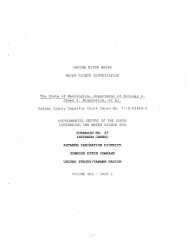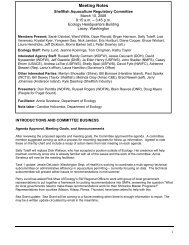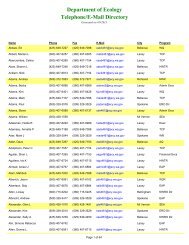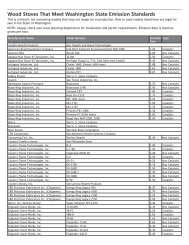General Permit for Biosolids Management - Washington State ...
General Permit for Biosolids Management - Washington State ...
General Permit for Biosolids Management - Washington State ...
Create successful ePaper yourself
Turn your PDF publications into a flip-book with our unique Google optimized e-Paper software.
<strong>General</strong> <strong>Permit</strong> <strong>for</strong> <strong>Biosolids</strong> <strong>Management</strong> Page 8<br />
“Public contact site” is land with a high potential <strong>for</strong> contact by the public. This includes, but is not<br />
limited to, public parks, ball fields, cemeteries, plant nurseries, turf farms, and golf courses.<br />
“Publicly owned treatment works” means a treatment works treating domestic sewage that is owned<br />
by a municipality, the state of <strong>Washington</strong>, or the federal government.<br />
“Range land” is generally open, uncultivated land dominated by herbaceous or shrubby vegetation that<br />
may be used <strong>for</strong> grazing or browsing, either by wildlife or livestock.<br />
“Receiving-only facility” means a treatment works treating domestic sewage that only receives sewage<br />
sludge or biosolids from other sources <strong>for</strong> further treatment and/or application to the land, and which<br />
does not generate any biosolids from the treatment of domestic sewage.<br />
“Reclamation site” is drastically disturbed land that is reclaimed using biosolids. This includes, but is not<br />
limited to, strip mines and construction sites.<br />
“Regional administrator" means the Regional Administrator of Region 10 of the Environmental<br />
Protection Agency or his/her authorized representative.<br />
“Residential equivalent value” means the number of residential equivalents determined <strong>for</strong> a facility<br />
under Chapter 173-224 WAC or a value similarly obtained under WAC 173-308-320.<br />
“Restrict public access” means to minimize access of nonessential personnel to land where biosolids are<br />
applied, through the use of natural or artificial barriers, signs, remoteness, or other means.<br />
“Saturated zone” means the zone below the water table in which all interstices are filled with water.<br />
“Septage managed as biosolids originating from sewage sludge” means septage managed as if it had<br />
originated from a sewage treatment process at a wastewater treatment facility including, but not<br />
limited to, meeting the sampling requirements in WAC 173-308-140, the monitoring requirements in<br />
WAC 173-308-150, the pollutant limits in WAC 173-308-160, the pathogen reduction requirements in<br />
WAC 173-308-170, and the vector attraction reduction requirements in this permit.<br />
“Septage management facility” means a person who applies septage to the land or one that treats<br />
septage <strong>for</strong> application to the land.<br />
“Septage” or “domestic septage” is liquid or solid material removed from septic tanks, cess pools,<br />
portable toilets, type III marine sanitation devices, vault toilets, pit toilets, RV holding tanks, or similar<br />
systems that receive only domestic sewage. Septage may also include commercial or industrial septage<br />
mixed with domestic septage if approved in accordance with WAC 173-308-020(3)(g).<br />
“Sewage sludge” is solid, semisolid, or liquid residue generated during the treatment of domestic<br />
sewage in a treatment works. Sewage sludge includes, but is not limited to, domestic septage; scum or<br />
solids removed in primary, secondary, or advanced wastewater treatment processes; and a material<br />
derived from sewage sludge. Sewage sludge does not include ash generated during the firing of sewage<br />
sludge in a sewage sludge incinerator or grit and screenings generated during preliminary treatment of<br />
domestic sewage in a treatment works.<br />
“Significant change in biosolids management practices” means, but is not limited to, the following: a<br />
change in the quality of biosolids that are applied to the land, either from class A to class B <strong>for</strong><br />
pathogens, or from Table 3 to Table 1 of WAC 173-308-160 <strong>for</strong> pollutant limits; the addition of a new<br />
area to which biosolids will be applied which was not previously disclosed during a required public<br />
notice process; <strong>for</strong> class B biosolids only, a change from nonfood crops to food crops, a change from<br />
crops where the harvestable portions do not contact the biosolids/soil mixture to crops where the<br />
harvestable portions contact the biosolids/soil mixture, or a change in site classification from land with a<br />
low potential <strong>for</strong> public exposure to land with a high potential <strong>for</strong> public exposure; or any change or<br />
deletion of a requirement established in an approved land application plan or established as a condition<br />
of coverage under a permit that would result in a decrease in buffer size, site monitoring, or facility<br />
reporting requirements, which was not otherwise provided <strong>for</strong> in the permit or plan approval process.



